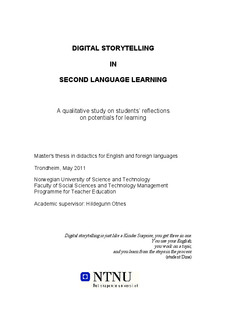| dc.description.abstract | This study focuses on the educational use of digital storytelling within second language learning from an emic perspective. Digital storytelling, which can be described as a combination of the old storytelling tradition and new technology, was originally used for other purposes than education and learning. This has however changed over the years. With the advent of new technology in schools, various forms of digital media production have become quite common as approaches to learning in several subjects. This was even further emphasized with the new curriculum from 2006, where digital skills were established as one of five basic skills. I have in my own teaching practice used digital storytelling as a learning activity since 2003.
This study’s main objective has been to explore young learners’ meta- reflections on potentials for learning when digital storytelling is used as a learner centered second language learning activity in lower secondary school. Data have been collected from questionnaires, semi-structured interviews and reflection logs and been analyzed thematically. Three overall themes were established, all with reference to the following main research question outlined for the study: What are the potentials for learning when digital storytelling is used as a second language learning activity in lower secondary school, as perceived by the students and expressed through their reflections?
I found that students understand digital storytelling as an all-embracing activity for learning in the sense that it can be used to obtain other goals, e.g. development of basic oral, written or digital skills, or be the goal in itself, e.g. to develop content understanding. The study also showed that increased motivation for academic work was generally related to variation in working method, more than to digital storytelling. A few differences between boys’ and girls’ reflections on the use of new technology were observed, but a majority of the students in this study related learning to being active in the learning process, e.g. by teaching others. In this respect, they pointed to digital storytelling as a relevant way of documenting and sharing knowledge. The study furthermore showed that scaffolding and contextualization were important premises for learning to take place and that students not only learn from their own digital storytelling productions, but also from those of their peers. | nb_NO |
